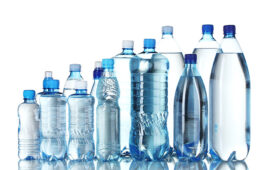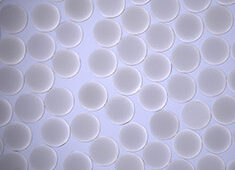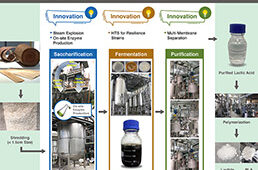The word “SLIPS” is coated with the SLIPS technology to show its ability to repel liquids and solids and even prevent ice or frost from forming. The slippery discovery has now been shown to prevent more than 99% of harmful bacterial slime from forming on surfaces. Image courtesy of Joanna Aizenberg, Rebecca Belisle, and Tak-Sing Wong. |
Biofilms may no longer have any solid ground upon which to stand.
A
team of Harvard scientists has developed a slick way to prevent the
troublesome bacterial communities from ever forming on a surface.
Biofilms stick to just about everything, from copper pipes to steel ship
hulls to glass catheters. The slimy coatings are more than just a
nuisance, resulting in decreased energy efficiency, contamination of
water and food supplies, and—especially in medical settings—persistent
infections. Even cavities in teeth are the unwelcome result of bacterial
colonies.
In a study published in the Proceedings of the National Academy of Sciences
(PNAS), lead coauthors Joanna Aizenberg, Alexander Epstein, and
Tak-Sing Wong coated solid surfaces with an immobilized liquid film to
trick the bacteria into thinking they had nowhere to attach and grow.
“People
have tried all sorts of things to deter biofilm build-up—textured
surfaces, chemical coatings, and antibiotics, for example,” says
Aizenberg, Amy Smith Berylson Professor of Materials Science at the
Harvard School of Engineering and Applied Sciences (SEAS) and a Core
Faculty Member at the Wyss Institute for Biologically Inspired
Engineering at Harvard. “In all those cases, the solutions are
short-lived at best. The surface treatments wear off, become covered
with dirt, or the bacteria even deposit their own coatings on top of the
coating intended to prevent them. In the end, bacteria manage to settle
and grow on just about any solid surface we can come up with.”
Taking
a completely different approach, the researchers used their recently
developed technology, dubbed SLIPS (Slippery-Liquid-Infused Porous
Surfaces) to effectively create a hybrid surface that is smooth and
slippery due to the liquid layer that is immobilized on it.
First described in the September 22, 2011, issue of the journal Nature,
the super-slippery surfaces have been shown to repel both water- and
oil-based liquids and even prevent ice or frost from forming.
“By
creating a liquid-infused structured surface, we deprive bacteria of
the static interface they need to get a grip and grow together into
biofilms,” says Epstein, a recent Ph.D. graduate who worked in
Aizenberg’s lab at the time of the study.
“In
essence, we turned a once bacteria-friendly solid surface into a liquid
one. As a result, biofilms cannot cling to the material, and even if
they do form, they easily ‘slip’ off under mild flow conditions,” adds
Wong, a researcher at SEAS and a Croucher Foundation Postdoctoral Fellow
at the Wyss Institute.
Aizenberg
and her collaborators reported that SLIPS reduced by 96–99% the
formation of three of the most notorious, disease-causing biofilms—Pseudomonas aeruginosa, Escherichia coli, and Staphylococcus aureus—over a 7-day period.
The SLIPS technology for preventing biofilm formation as compared to a Teflon coated surface. Photo courtesy of Joanna Aizenberg and Tak-Sing Wong. |
The
technology works in both a static environment and under flow, or
natural conditions, making it ideally suited for coating implanted
medical devices that interact with bodily fluids. The coated surfaces
can also combat bacterial growth in environments with extreme pH levels,
intense ultraviolet light, and high salinity.
SLIPS
is also nontoxic, readily scalable, and—most importantly—self-cleaning,
needing nothing more than gravity or a gentle flow of liquid to stay
unsoiled. As previously demonstrated with a wide variety of liquids and
solids, including blood, oil, and ice, everything seems to slip off
surfaces treated with the technology.
To
date, this may be the first successful test of a nontoxic synthetic
surface that can almost completely prevent the formation of biofilms
over an extended period of time. The approach may find application in
medical, industrial, and consumer products and settings.
In
future studies, the researchers aim to better understand the mechanisms
involved in preventing biofilms. In particular, they are interested in
whether any bacteria transiently attach to the interface and then slip
off, if they just float above the surface, or if any individuals can
remain loosely attached.
“Biofilms
have been amazing at outsmarting us. And even when we can attack them,
we often make the situation worse with toxins or chemicals. With some
very cool, nature-inspired design tricks we are excited about the
possibility that biofilms may have finally met their match,” concludes
Aizenberg.
Aizenberg
and Epstein’s coauthors included Rebecca A. Belisle, research fellow at
SEAS, and Emily Marie Boggs ’13, an undergraduate biomedical
engineering concentrator at Harvard College. The authors acknowledge
support from the Department of Defense Office of Naval Research; the
Croucher Foundation; and the Wyss Institute for Biologically Inspired
Engineering at Harvard University.
Source: Harvard University






